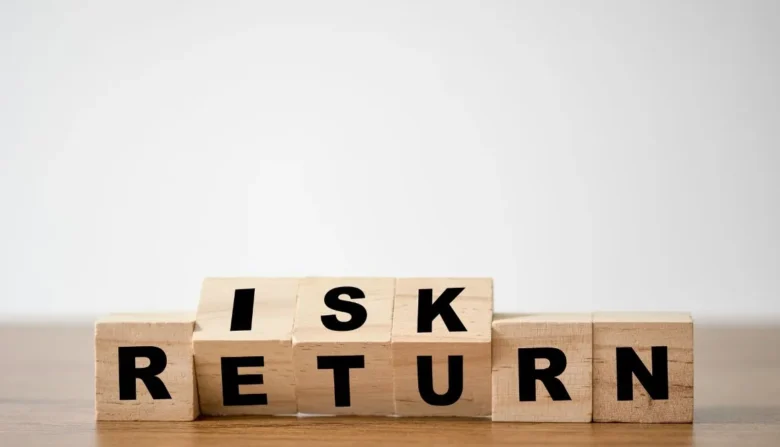“Risk” and “return” are two words that often appear in the investment world. These two concepts are at the heart of every financial decision and are closely related. Understanding how risk and return are related allows investors to make informed choices and develop a plan that aligns with their goals. Risk and return are essential to investing, not something to fear, so don’t be intimidated by this relationship.
What Risk Means in Investing
Investing means taking the risk that the outcome won’t meet your expectations. This can lead to a lower-than-expected return or a loss of (part of) your invested capital. There are many types of risk. Market risk arises from economic fluctuations, while company-specific risk arises from problems with a specific company. Investing always involves risk, but the degree of risk depends on the type of asset. For example, stocks are riskier than government bonds but also offer a greater chance of profit.
What Return Means in Investing
Yield refers to the income an investor receives from an investment. Yield can consist of dividends, interest, or capital gains. TheYour yield is the difference between the price you buy a stock and the price you sell it. you buy a bond, the periodic interest you receive is also part of your yield. The goal of investing is to make money and grow your wealth over time. HowBut your earnings are usually based on how much risk you’re willing to take.he Link Between Risk and Return
Risk and return are twointerdependentenerally, the more money you can expect to earn, the more risk you take. Savings accounts and government bonds are examples of safe investments that typically offer lower returns but also lower risk. Stocks and real estate are examples of riskier investments that can grow faster but also carry the possibility of loss. This link suggests that investors should carefully consider how much risk they are willing to take to achieve their desired return.
Finding the Right Balance Between Risk and Return
For most investors, finding the right balance between risk and return is a challenge. Taking too much risk can lead to significant losses. Conversely, too little risk can lead to missed growth opportunities. Beginners often start with safer investments and move to riskier ones as they learn more about the market. One strategy for managing risk and return is spreading your money across different assets, also known as diversification. By holding different stocks, bonds, and other investments, investors can understand the impact of a single loss while still pursuing healthy returns.
Your Personal Goals and the Risk You’re Willing to Take
Risk tolerance refers to each investor’s appetite for risk. Some are willing to accept significant volatility in their investments as long as it means they can achieve higher returns. Others prefer stability, even if it means earning less. Your risk tolerance depends on factors such as your age, financial situation, and personal ambitions. For example, younger investors may be willing to take greater risks because they have more time to recoup losses. On the other hand, retirees may prefer safer investments to protect their capital.
Short-Term and Long-Term Perspectives
Time has a huggiantpact on the perception of risk and return. Markets can be very volatile in the short term, with values rising and falling rapidly. ThiSuch volatilitykes short-term investments riskier, as you have little time to recoup losses. However, over time, markets stabilize, and investments like stocks can deliver strong returns even after brief periods of decline. People with a long-term perspective are generally better at managing risk because they focus on the big picture, not on small daily fluctuations.
The Importance of Understanding Risk and Return
If you don’t understand risk and return, you might think investing is gambling. But in reality, informed investing is quite different from luck. Understanding how risk and return work allows investors to make better choices, stay calm during market downturns, and stay focused on their long-term goals. ThiThe processso helps investors choose investments that suit them, rather than blindly following trends that may not align with their plans. Understanding how this relationship works can increase confidence and alleviate fears that hinder investing.
Risk and Return in Action: Some Examples
By considering government bonds and technology stocks as two types of investments, you understand how risk and return interact. Government bonds pay a small but stable annual interest rate and have a lower risk of default. However, technology stocks can double in value if the company performs well but can decline in value if performance disappoints. Bonds offer low risk and low return, while stocks offer high risk and high return. An investor’s goals and the amount of risk they are willing to take will help them choose between the two.
Conclusion
Risk and return are two of the most important factors to consider when investing. They influence every investment decision an investor makes. Higher returns generally mean more risk is taken, but everyone must determine how much risk they are willing to take based on their own goals and circumstances. By understanding the relationship between risk and return, investors can develop a balanced plan that protects and grows their capital. Investing is not about completely avoiding risk but about managing it wisely to achieve a good return and, thus, a secure financial future.
FAQs
1. What does it mean to take risks in investing?
Risk refers to the possibility of losing money or not achieving the expected return on an investment.
2. What does “return” mean in investing?
Return is the income an investor receives from an investment. This can come from interest, dividends, or selling the investment at a price higher than the purchase price.
3. Are higher returns always better?
Higher returns generally come with higher risks. If the returns don’t align with the investor’s goals or risk appetite, they may not always be beneficial.
4. How can beginners manage risk?
Beginners can reduce risk by diversifying their asset allocation, starting with safer investments, and focusing on the bigger picture.
5. Why is it important to understand risk and return?
By understanding risk and return, investors can make informed decisions, avoid unnecessary losses, and maintain financial progress.




